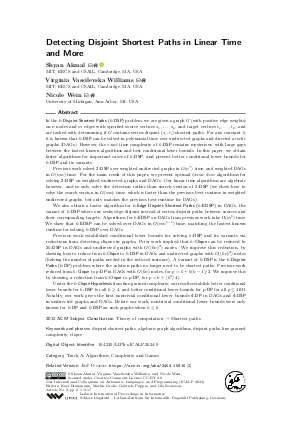@InProceedings{akmal_et_al:LIPIcs.ICALP.2024.9,
author = {Akmal, Shyan and Vassilevska Williams, Virginia and Wein, Nicole},
title = {{Detecting Disjoint Shortest Paths in Linear Time and More}},
booktitle = {51st International Colloquium on Automata, Languages, and Programming (ICALP 2024)},
pages = {9:1--9:17},
series = {Leibniz International Proceedings in Informatics (LIPIcs)},
ISBN = {978-3-95977-322-5},
ISSN = {1868-8969},
year = {2024},
volume = {297},
editor = {Bringmann, Karl and Grohe, Martin and Puppis, Gabriele and Svensson, Ola},
publisher = {Schloss Dagstuhl -- Leibniz-Zentrum f{\"u}r Informatik},
address = {Dagstuhl, Germany},
URL = {https://drops.dagstuhl.de/entities/document/10.4230/LIPIcs.ICALP.2024.9},
URN = {urn:nbn:de:0030-drops-201529},
doi = {10.4230/LIPIcs.ICALP.2024.9},
annote = {Keywords: disjoint shortest paths, algebraic graph algorithms, disjoint paths, fine-grained complexity, clique}
}

 Creative Commons Attribution 4.0 International license
Creative Commons Attribution 4.0 International license


